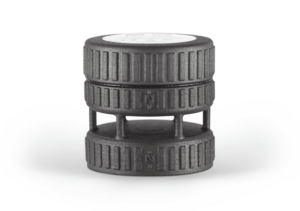FT Technologies is a leading manufacturer of rugged wind sensors for unmanned aerial vehicles (UAVs), and the company’s new FT205 is one of the lightest on the market. Gordon Bease, FT Technologies’ Director of North American Operations, has commented on how the FT205 is opening up new markets and opportunities for the company.
Why did you decide to design a lightweight wind sensor?
The FT205 has been specially designed for drones, and in particular the sub-market of drones which fall under the sUAS category. These vehicles have strict limitations on payload weight, and lighter is obviously better. We have been able to take our proven and reliable Acu-Res core technology, and package it in a body which weighs <100g, but maintains the physical toughness and reliability that FT Technologies is renowned for.
Why would someone want to use a wind sensor on a drone?
We see three main thrusts here.
1) As a meteorological sensor, our products measure wind speed, wind direction and acoustic air temperature. These measurements can be used as part of a mobile drone weather station: maybe used for environmental monitoring, atmospheric measurements, pollution monitoring, precision agriculture etc. The wind input can be used to normalize or provide a reference point for the other measurement sensors on a drone, for example in methane detection or CBRNe applications, where consistent quantitative concentration results are required, but the wind at the measurement location may be changing from day to day and affecting the concentration profile. A wind sensor can also be used for drone flight range estimation – there is a risk of a rotor UAV not making it back to base before running out of power if it has to return against a headwind. A wind sensor can help calculate the safe operating flight range in that case. Our UAV sensors all incorporate an integrated compass, so that true wind can be separated from apparent wind, and true wind measurements can therefore be taken from a moving UAV.
2) The second category is where the wind sensor provides information to a flight control system. Drones that operate around or close to large structures such as wind turbines, transmission towers or buildings in urban environments, are prone to a lot of unexpected wind gusts and turbulence. Using a wind sensor as part of a Dynamic Positioning System can help to protect the public, the UAV and surrounding objects from collision, injury and damage. For example, in the case of wind turbine inspection, you want the drone to be close enough to the turbine to capture enough detail, but the closer you are, the more responsive a control system is required.
In package delivery, the drone’s weight varies enormously from pre to post delivery, and so dynamically it behaves much differently – again, a wind sensor can help with position control, maneuverability and collision avoidance.
3) The third thrust we are seeing, is that users want to replace or augment pitot tube operation. Pitot tubes have been in use for a long time, and are an established technology, but we hear from end users that they suffer from two main issues: inaccurate low air speed measurement, and inherent one-dimensional direction reporting. Our products accurately measure the air speed range from 0-145 knots (0-75m/s) in a full 360 degrees. This opens up opportunities in rotor UAVs where the absence of a pilot causes difficulty with drift detection and compensation during hovering and landing.
So, what makes your technology different and advantageous for drone use?
We are unique in the market place in that we use acoustic resonance to measure wind speed, direction and acoustic air temperature. Acu-Res technology provides a superior signal/noise ratio, which enables high levels of data availability and accuracy in acoustically and vibrationally noisy environments. We have designed the FT205 to withstand shock and vibration and it has passed all our HALT tests at 60G. This may sound like overkill, but some fixed wing drones are launched by catapult, and this can place enormous mechanical stress on sensors, so we are confident that our FT205 is tough. In addition, since UAV’s are essentially mobile radio transmitters/receivers, we have designed the FT205 to be immune to Radio Frequency Interference, and to have low enough emissions that it will not affect neighbouring sensors on the drone.
How do you see the drone market developing?
It is a very interesting market for FT Technologies, and I believe that it can be a driver of innovation. It seems that every day I read about a new application for drones, and many of those need a wind sensor. The global UAV market is currently constrained by the lack of an Unmanned Traffic Management System, and restrictive rules governing Beyond Visual Line of Sight, Flight over People and nighttime operations, but I believe that these are all problems with solutions. Once solved, the UAV market will exponentially expand and drones will become ubiquitous. I am very much looking forward to my first trip in an air taxi!



















